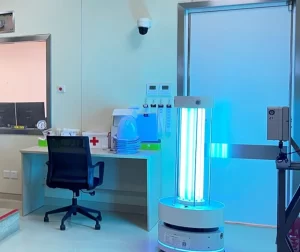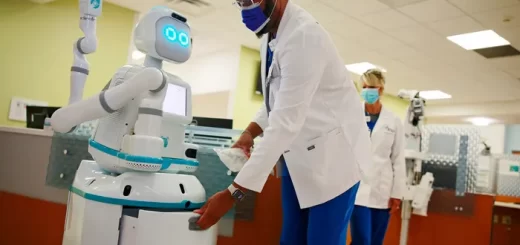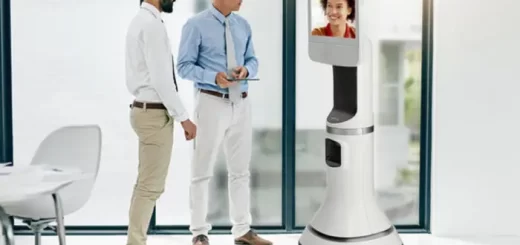Saul UV disinfection robot review, use, advantages and disadvantages
Saul is the UV disinfection robot, It was developed by Xenex Disinfection Systems, this robot uses high-intensity ultraviolet (UV) light to kill pathogens on surfaces. It’s used in hospitals and other healthcare facilities to fight infections. Saul can zap 99.99% of common bacteria in just 2 minutes. It offers effectiveness in disinfecting surfaces and can reach areas that are difficult for humans to clean.
Saul UV disinfection robot
Saul is a cool bot, It uses powerful UV light to zap germs on surfaces. Saul‘s UV rays are harmless to humans, so you don’t have to worry about getting zapped yourself. Weighing only 135 pounds, Saul can easily disinfect hard-to-reach areas. Saul‘s small size and maneuverability make it perfect for navigating tight spaces and battling nasty bacteria and viruses in hospitals.
Saul robot can interact with people in urban environments. It can learn from its interactions and improve its performance. SAUL can navigate busy sidewalks and crosswalks, and use public transportation. SAUL is designed to be approachable and non-threatening, making it easier for people to accept robots into their daily lives. However, its disadvantages include its high cost and the potential for damage to surfaces if used improperly.
Saul uses high-intensity ultraviolet (UV) light to kill bacteria and viruses on surfaces. It is used in hospitals to help prevent the spread of infections. Saul operates silently, so it can disinfect the most sensitive areas without disturbing patients or staff.
Advantages of Saul UV disinfection robot
Saul‘s UV C rays are lethal to a wide range of pathogens, including bacteria, viruses, and fungi. This makes it incredibly effective in preventing HAIs, which can sicken and kill patients. Unlike some disinfectants, Saul doesn’t leave behind any harmful residues or fumes. This makes it safe around patients, food, sensitive equipment, and staff, even in sensitive areas like intensive care units.
Unlike traditional cleaning methods that use harsh chemicals, Saul uses UV light, which is a safe and eco-friendly way to disinfect surfaces, even for staff with no prior experience with robotics. Its simple controls and autonomous navigation make it a breeze to operate. This is important for protecting both human health and the environment.
While Saul has an initial investment cost, it can save hospitals money in the long run by reducing HAIs and the associated costs of treating infections. Saul uses powerful ultraviolet (UV-C) light, which is proven to kill up to 99.99% of bacteria, viruses, and other pathogens on surfaces. This makes it a valuable tool for preventing the spread of infections.
Saul is a self-contained robot that can be operated with a simple touchscreen interface. This makes it easy for anyone to use, even without specialized training. Saul is relatively small and lightweight, making it easy to move around and use in different settings. It can be used in hospitals, clinics, nursing homes, schools, offices, and homes.
Saul can disinfect a room in as little as 10 minutes, making it a quick and efficient way to keep your environment clean. It’s autonomous, so you can just set it loose and let it work its magic. Saul can tackle a variety of surfaces, from floors and walls to furniture and medical equipment. Its adaptability makes it a valuable weapon in the fight against germs.
Disadvantages of Saul UV disinfection robot
UV C light only works on surfaces it directly shines on. So, shadows or cluttered areas might require manual cleaning to ensure thorough disinfection. While Saul is incredibly effective, it’s not a replacement for traditional cleaning methods. Regular cleaning with disinfectants is still necessary to remove dirt, dust, and organic matter.
Like any other machine, Saul requires regular maintenance to function properly. This includes things like changing bulbs and keeping the sensors clean. Saul operates on batteries, which need to be recharged or replaced regularly. This can add to the operational costs.
UV light can damage some materials, such as fabrics and plastics if they are exposed to it for too long. It is important to use Saul carefully and follow the manufacturer’s instructions. UV light can only kill germs that it directly shines on. So, if there are any nooks and crannies in a room, Saul might miss them. This necessitates thorough cleaning procedures alongside Saul’s disinfection.
UV light can be harmful to human skin and eyes. It is important to take precautions, such as never looking directly at the light when Saul is operating, and wearing protective clothing and eyewear. Saul is not able to disinfect surfaces that are high up or in hard-to-reach places. This may require additional cleaning methods to be used in these areas.
While Saul is great for hard surfaces, it can’t disinfect porous materials like fabrics or carpets as effectively. These might require different cleaning methods. UV light only works on surfaces that it can directly reach. This means that Saul may not be effective in areas with shadows or obstructions.
Saul robots can be quite expensive, making them a significant investment for smaller facilities or budget-conscious organizations. Like any machine, Saul requires regular maintenance to keep its UV lamps functioning optimally. This adds to the overall.
Laboratory robotics uses, advantages and disadvantages
Computers in Medicine uses, advantages and disadvantages
Robotic surgery cons, pros, uses and How does robotic surgery work?
Artificial intelligence in medical field advantages & how AI medical diagnosis changes medicine
Surgical robots types, advantages, disadvantages, How is robotic surgery different from traditional
You can follow Science Online on Youtube from this link: Science online
You can download Science online application on Google Play from this link: Science online Apps on Google Play




